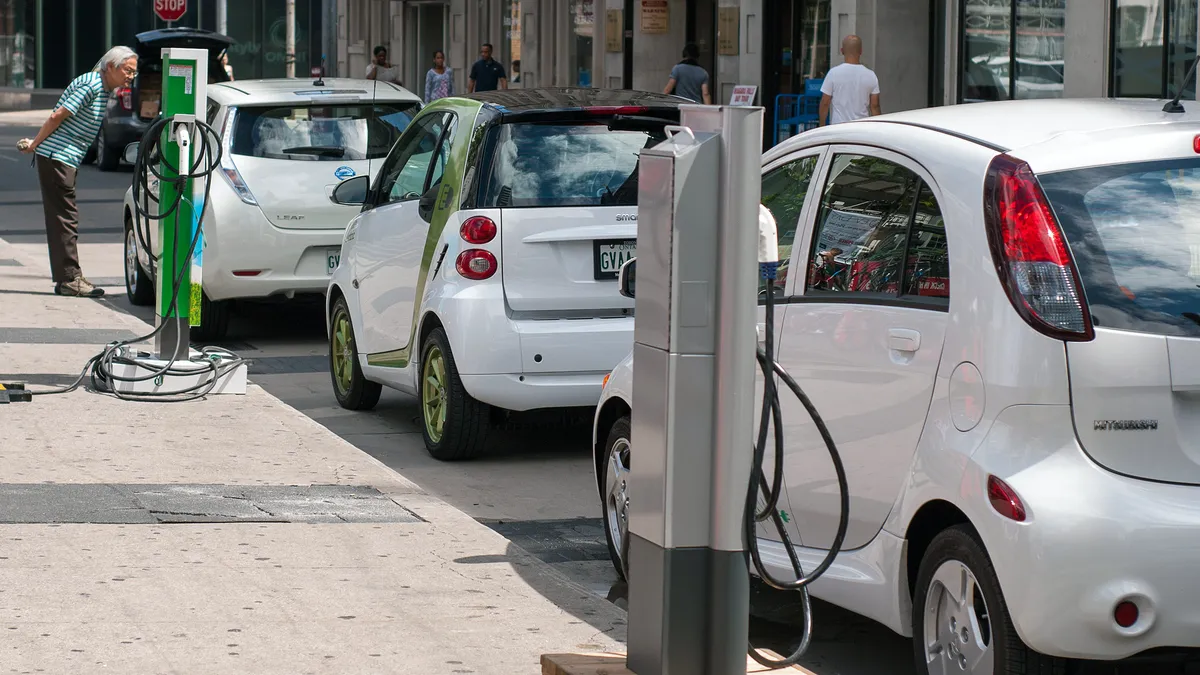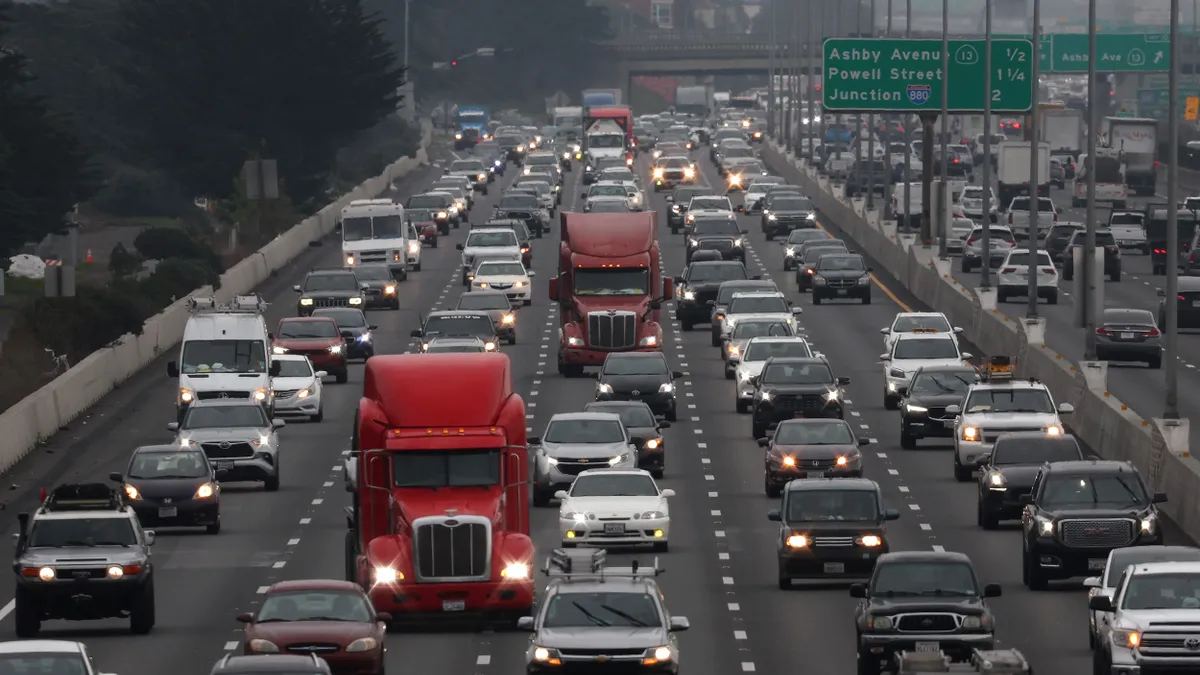There are about 6,200 electric vehicles on the roads in Massachusetts, but in less than a decade the state wants to reach 300,000
That means by 2025, the Bay State is targeting a 50-fold increase in zero-emission vehicles (ZEV). The transportation sector makes up 40% of greenhouse gas emissions in the state, and the state's Zero Electric Vehicle Commission set the target to help Massachusetts meet its environmental goal of reducing emissions 25% below 1990 levels by 2020, and 80% by 2050.
For National Grid, meeting the goal will mean a lot of work in just seven years. The utility has about 2,500 electric vehicles in its territory now, but would see that number rise to about 120,000.
"What's important to us is that we take action quickly to help accelerate EV adoption because those targets are less than 10 years away at this point--and still feel very far from being achieved," said Karsten Barde, principal program managers in National Grid's New Energy Solutions office.
The utility has submitted a three-year electric vehicle pilot that has three principle goals. In addition to increasing the number of charging ports in its service territory, National Grid will also work to boost awareness of electric vehicles among its customers. And it will pay close attention to how the new load impacts the distribution network, considering future demand management and ancillary services possibilities.
A report from the U.S. Department of Energy's National Renewable Energy Lab earlier this year estimated that to reach Massachusetts' 300,000-vehicle goal, between 40,000 and 90,000 charging ports will be needed. National Grid's initial phase will be much smaller, of course: about 1,200 level 2 charging ports and 80 DC fast chargers, between more than 100 locations.
"It's a new foray for us," said Brian Cronin, director of marketing and communications for New Energy Solutions. "A lot remains to be seen, about what is most effective model to deploy this infrastructure. So we're being a little more prudent, taking smaller bites."
How the program will work
National Grid's $24 million program will utilize a "make ready" approach, where it essentially helps prepare a host location for an EV charging company to install ports.
The program aims to simplify and defray the costs to site hosts through a combination of efforts, including constructing any upgrades on the utility side of the meter and reimbursing the site host for the cost of any improvements on their side of the meter. The utility will also provide a rebate towards certain hosts' Level 2 charging stations.
Locations will need to commit to host the charging equipment for at least five years.
The make-ready approach could help stave off turf battles seen in other states between utilities and private car charging companies, who worry that utilities will squeeze them out of the market by rate-basing charging networks. In California, for instance, private chargers have pushed for smaller utility charging pilot programs, prompting regulators to send a large EV charging pilot from PG&E back to the utility for revision.
Thus far, other sector stakeholders have been generally supportive of the charging plans from National Grid and fellow utility Eversource, Cronin said, though there is a learning curve for everyone, including the utility, about possible charging sites, and infrastructure companies.
Everyone is "trying to find out where they fit in the value chain," he said.
Given the scope of Massachusetts' EV goals, the pilot program is also part research and preparing for future use cases.
National Grid told the Massachusetts Department of Public Utilities that it wants to prepare for future integration of EVs into its electric distribution system by implementing a research plan "that will use detailed utilization and transaction data from participating charging site hosts to evaluate the electric system impacts of charging stations."
The plan will consider potential demand response approaches that "could be conducted via charging stations or via direct communication to vehicles, and will evaluate other technology integration approaches for high-capacity Direct Current Fast Charging stations," according to the application.
A collaborative effort
The American Council for an Energy-Efficient Economy ranks Massachusetts first in the nation (alongside California) for energy efficiency. A part of the state's success is the Mass Save program, a collaboration of about a dozen gas and electric utilities and energy efficiency service providers that work with the Massachusetts Department of Energy Resources to provide incentives and trainings, and to inform customers about efficiency opportunities.
The program has been running for about 30 years, and returns almost $5 in benefit for every dollar spent. While efficiency and EV infrastructure may not be apples-to-apples, Cronin said state regulators strongly hinted they wanted utilities to work collaboratively.
"Similar to some of the EE issues back in the early '80s and '90s, collectively is the best way to solve that problem and increase adoption rates," he said.
Eversource has filed its own electric vehicle plan with regulators, but the two utilities now hold bi-weekly calls to discuss progress. “We thought it was pretty important to have a consistent statewide model, at least for the first few years," Cronin said.
Eversource spokesman Mike Durand echoed that idea. "It makes sense for both utilities to collaborate as we work through program details and develop outreach," he said. "We share the same objectives, with the ultimate goal of promoting the adoption of electric vehicles through an increased number of charging stations across the commonwealth."
Eversource's plan also includes a consumer outreach campaign and distribution upgrades in strategic areas to best help electric vehicle adoption.
"Consistency will benefit customers regardless of in which company’s service area they live or work," Durand said.
The utility incentive
National Grid's proposal includes a performance incentive that would be paid back to the utility for charger buildouts. Again, it borrows from what has worked for the company before.
"We thought it made sense to explore a mechanism similar to our energy efficiency programs," said Cronin. "So, the performance incentive back to National Grid shareholders would be in proportion to how many of our target sites we deploy."
That figure is 5.5%. Targeting 140 sites, National Grid shareholders could earn up to $1.25 million in the pilot phase. But the utility's customers make up about 40% of electric vehicles in Massachusetts, and so the incentives could scale up quickly.
“From our perspective, this is a demonstration of a new approach to helping deploy charging infrastructure as well as consumer education," said Cronin.
"It's great to see so many different program models being proposed," said Barde. "Hopefully this is just the beginning."





















